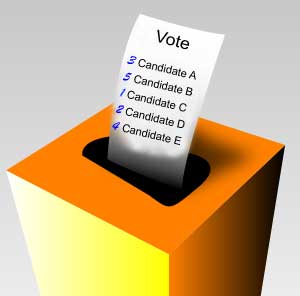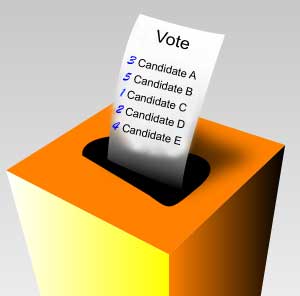
Although their official report isn’t due to be published until the 23rd of April, on Wednesday the Guardian reported that the Joint Committee on Lords Reform has decided to back an ‘open preferential voting system’ rather than the government’s preferred Single Transferable Vote (STV) for electing members to a reformed House of Lords. Open preferential voting is a hybrid electoral system which allows voters to either express a rank ordering of individual candidates in the same manner as STV, or to select a list of candidates chosen by a political party, much like a closed list proportional representation system. In Australia, where the method is used to elect the Senate, this is known as voting ‘below’ and ‘above’ the line respectively due to the design of the ballot paper.
The Joint Committee’s decision has been strongly criticised by the Electoral Reform Society (ERS), who have campaigned for STV since 1884, as being ‘a dog’s breakfast’. The ERS’s main objection is that the introduction of above the line voting is that closed list PR systems would increase the power of political parties to influence who gets elected, which, in the words of their chief executive Katie Ghose, would result in the Lords being ‘a mini-replica of the commons, full of party-politicians with pre-set loyalties’ whilst ‘STV would help create a chamber free to provide objective scrutiny’. This argument is based on evidence from Australia that, given the choice, the vast majority (around 95%) of voters choose to vote above the line and so it is a de facto closed list PR system.
At first glance, research suggests that the ERS is correct in their argument: central party control over candidate selection and position on party lists tends to increase party unity in legislative behaviour. Further scrutiny however suggests that the picture is complicated by the fact that the proposed reforms would elect members to the Lords for single, non-renewable, 15 year terms. Research into party discipline, such as that by Christopher Kam, suggests that party discipline is driven by a combination of socialisation, positive incentives offered by party leaders for toeing the party line, and disciplinary measures party leaders can impose for breaking party discipline. One of the strongest incentives party leaders can offer in a closed list PR electoral system is a high place on the party list (and a corresponding better chance of re-election) and conversely leaders can punish rebellious MPs by moving them down or off the list. It is this aspect of closed list PR systems that explain why they tend to have high levels of party discipline. That members of a reformed Lords would be unable to stand for re-election effectively removes that effect from the equation, and there is no evidence to suggest that Lords elected under an open preferential system would be any more likely to follow the party leadership than those elected under STV.
The evidence of the very high use of above the line voting in Australia is also more complicated than it first appears. The electoral rules in Australia require that if you vote below the line you are required to give a preference ordering to every candidate on the list. At the 2010 election, there were 84 candidates for the Senate in New South Wales, so perhaps we should not be surprised that 97.76% of voters in NSW voted above the line – requiring a preference ordering of 84 candidates is a very high demand to make of voters. The evidence also suggests that the number people voting above the line is a direct consequence of the number of candidates standing in the election, at the 2010 election Tasmania and the Australian Capital Territory had only 24 and 9 candidates respectively, and the rates of above the line voter were much lower at 79.82% and 75.93%.
This raises two questions: how many candidates are likely to stand for election in each Lords electorate and how many preferences will voters be required to express? The draft reform bill proposes electing the 240 elected Lords in thirds, with 80 seats contested in each election, in constituencies of around 5-7 seats, with roughly one member for every 570,000 voters. Conveniently, this yields constituencies of roughly similar size to the number of voters in the Australian states of Victoria and NSW which elect 6 Senators each (except in double dissolution elections when they elect 12). At the last election these states fielded 60 and 84 candidates respectively. It would be rash to say that an elected Lords will definitely have an equally high number of candidates, but multimember constituencies with large electorates tend to have high numbers of candidates. Even if the constituencies of a reformed Lords had only a third of the candidates as their Australian counterparts, a full preference ordering would require voters to assess between 20 and 28 candidates.
The current proposal in the draft reform bill avoids this difficulty by only requiring voters to express as many preferences as they want to. Though this may seem like a reasonable suggestion and is the norm in STV elections, it is important to understand the consequences this has on voting behaviour. Evidence, again from Australia, though this time from state elections (where full preference listing is not required) suggests that the majority of voters will only cast a single preference. The result of this is a high number of votes being ‘exhausted’ (having no preferences left after the voter’s preferred candidate(s) have been eliminated) before the final count. In layman’s terms: they needn’t have bothered casting their vote at all.

If, as advocates of STV tend to be, we are interested in taking into account the preferences of as many people as possible in choosing representatives this is clearly problematic. An obvious solution to this is to encourage voters to express a certain number of preferences, or as is the case in Australia, require them to do so. However, this makes higher demands of voters than simply casting a single vote, which in turn leads voters making mistakes on their ballot paper. The introduction of above the line voting for Australian Senate elections was designed to overcome just this problem. Prior to its introduction in 1984, nearly 1 in 10 votes cast in Australian senate elections were counted as ‘informal’ (Australian political parlance for an incorrectly filled in vote that is then discarded). This was halved at the first election following the introduction of above the line voting, and at the last election only 3.75% votes were counted as informal.
It is not clear yet whether the Joint Committee will recommend some form of requirement to express a certain number of preferences, though given their advocacy for open preferential voting it would not be surprising if they did. Although it has problems of its own, as a method of overcoming some of the difficulties of STV it is worth serious consideration, and not simply dismissed as it has been by the ERS. Both of these options have costs but as students of electoral systems have known since Kenneth Arrow’s famous theorem, no electoral system is perfect. Ultimately the government will have to choose between large numbers of voters choosing pre-determined preference orderings by voting above the line or large numbers of voters having their preferences ignored because they did not express them properly on the ballot paper.







6 Comments
Above the line voting defeats the main advantage of STV over all other systems – the freedom of choice that it offers voters.
Even if Chris Prosser is right that the limited term proposed for a revised House of Lords would protect its members from being over-disciplined party hacks because of above the line voting, the system would still restrict voters’ choices.
I certainly agree with Chris Prosser that, if below the line voting is allowed, we should encourage voters to express as many choices as they wish and not to restrict themselves to one party but I would strongly oppose compulsion. A voter has the moral right – and should have the legal right – to say, in effect, I cannot – or do not want to – choose between the rest of the rascals.
We should educate voters to express their choices but not force them. Those who express few choices will reduce their chances of influencing the election result, but that is up to them.
We have a right to vote. In the name of freedom we should also have the right to abstain either completely or partly.
Thanks for your comments Anthony, you raise an interesting point I’d like to address. Although there is certainly an argument to be had about whether or not the state has any right to compel its citizens to vote (or at least turn up to the ballot box, as is the case in Australia), the same argument doesn’t really apply to the ballot paper itself.
Any voting system necessarily has some degree of compulsion in that it forces voters to express their preferences in a particular way. Take even a simple election between two candidates for one seat. Imagine you have three voters: the first thinks one candidate is the most wonderful candidate ever to run for elected office and the other candidate is the worst candidate to ever run. The second voter thinks one candidate is the second worst person ever to run for office but they also think the other candidate is the absolute worst person ever to run. The third voter is completely indifferent between the candidates but feels it is their civic duty to vote so they flip a coin to decide between them. All three voters are compelled to express their very different preferences in the simple form of one or the other candidate.*
Imagine the above election repeated 5 times after each electoral term has expired, the voters have been compelled 5 times to cast their vote in a particular way. Now imagine a different election where each voter had to choose who they wanted to fill the 5 seats available to them. I see no reason why compelling them to choose 5 candidates is any different to the situation I previously described just because they have to choose them at the same time.
It would be impossible to have an electoral system that did not have some element of compulsion in it. If we agree that some form of electoral system is necessary, then we have to accept some degree of compulsion. I think the Australian system goes too far in requiring a full preference ordering, but I think there is a strong argument to be made for requiring voters to give a certain number of preferences. I would provisionally suggest requiring the same number of preferences as there are seats up for election.
To address your first point, introducing above the line voting doesn’t force the voter to vote above the line – anyone can choose to vote below the line if they want – but when there are a large number of candidates, and full preferences are required, it makes the burden on the voter very high. Everyone that votes above the line chooses to do so. Just because voters are lazy it doesn’t mean their freedom of choice is limited. Forcing voters to choose particular candidates is just as much compulsion as above the line voting – each requires voters to express their preferences in a particular way.
I should point out that I don’t actually think open preferential voting is the best solution to the problems of STV. For what it’s worth, I think an STV system that requires voters to express a minimum number of preferences is a better option. The point of my blog post was more that the open preferential system proposed by the Joint Committee is one solution to the very real problems with STV, and that by dismissing it out of hand advocates for straight STV such as the ERS are being blind to its faults. I think the Joint Committee should be congratulated for trying to address the complexities of STV in a constructive manner and not condemned and accused of trying to hijack Lords Reform in the interests of their party leaders. Given that those same party leaders are the ones proposing straight STV, I think that is a highly dubious argument.
*A possible exception to this is an interesting voting system proposed by Balinski and Laraki, which they term ‘majority judgement’ which allows for different levels of support for each candidate.
It is interesting to note that the issue of democratising (at least somewhat) our second house of parliament seems to be falling into the trap of addressing the wrong problem. This is because we have forgotten that we used to elect parliament to constrain the monarch; now we have other constraints on the monarch – that they are not Head of Government.
If we want to elect the political party that is to form the next government, we should directly elect an Executive Prime Minister as Head of Government. [Aside. And there is no reason not to do that as a constitutional monarchy; ie with separate Head of State.]
What we need in addition, and we used to have, is a Parliament that constrains the (Head of) Government – such that there is a balance of powers.
By putting an elected House of Lords into the pocket of political parties (a position in which the House of Commons is already the (over-)proud servant), we do not actually improve our democracy.
We need a house of parliament that is more separate from the main political parties than is the Commons. Yet we see here nothing but an attempt to place the Lords as more subservient to the political parties (now directly rather than through the Parliament Acts and the Commons) than they are currently.
It will not do!
Best regards